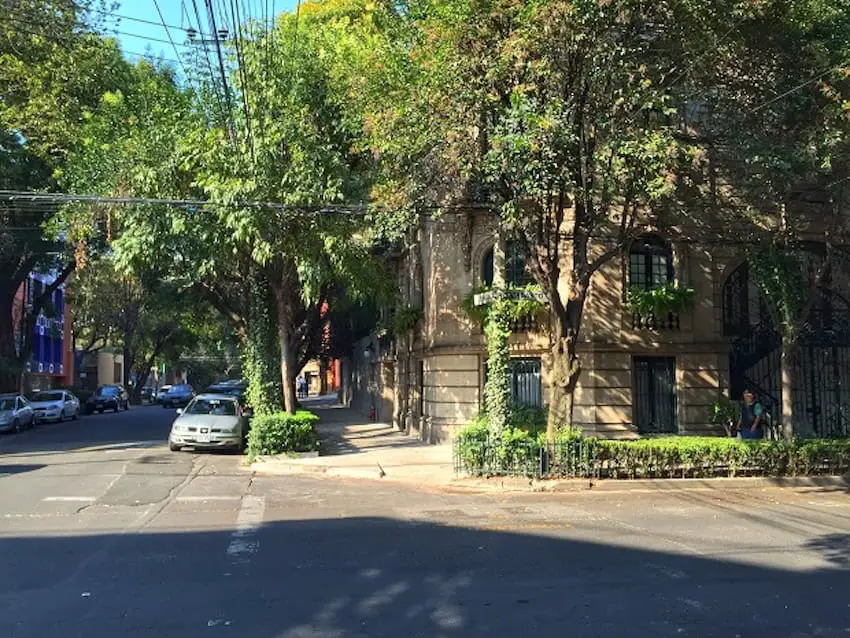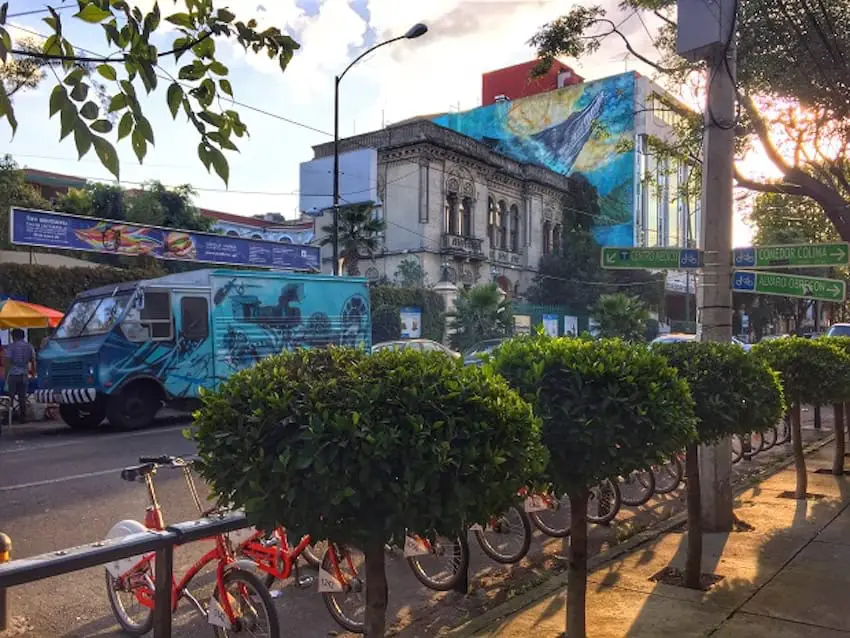Borough: Cuauhtémoc
Established: 1902
Location: 1.5 km southeast of the Angel de la Independencia
Pre-Columbian inhabitants: Mexicas

Who lives here
La Roma is divided into Roma Norte and Roma Sur at Calle Coahuila and La Romita in the northeast section of Roma Norte. Roma Norte is known for its verdant streets, cozy cafes, upscale boutiques and magnificent architecture, making it a magnet for tourists, expats and upper-middle-class Mexicans. Roma Sur is much more laid back, and you’re likely to bump into traditional mom-and-pop shops throughout its largely residential streets.

In contrast to its neighbors, La Romita is a small yet distinctly local area which centers around the popular plaza of the same name. Known as the backdrop to Luis Buñuel’s film “Los Olvidados,” the center of the neighborhood fights to retain its historical charm and is dotted by traditional tortillerías, tacos stands and a church. Clues of modernization abound, however, and a walk around reveals colorful murals and a trendy cervecería.
The vast majority of inhabitants are between 15 and 64 years of age, running the gamut of professionals, creatives and digital nomads. Expect to hear a collection of languages as you wander, from French to English.
A brief history of La Roma
In pre-Columbian times, a small island village called Aztacalco — “in the house of the herons” — stood in Lake Texcoco on the outskirts of Tenochtitlán, in what is now the neighborhood of La Romita. As the lake was drained, the area remained on the periphery of Mexico City.
The modern neighborhood of La Roma, believe it or not, would not be here if not for the circus. Specifically the Orrin Circus, established by an English family who brought their tented entertainment system from the United Kingdom to the United States and then traveled South America before building a permanent circus in Mexico City in 1891. Less than a decade later, Eduardo Walter Orrin presented plans for a new residential area with green spaces and wide boulevards.

Et voilà: La Roma was born.
The timing couldn’t have been more impeccable. With the wealthy inhabitants of a crumbling Historic Center were scrambling for relocation options, where could be better than La Roma? Porfirio Díaz’s government agreed to assist with the funding of its French-style Art Nouveau houses and paved, tree-lined streets. What was really attractive to newcomers was the included drinking water, sidewalks, street lighting and drainage system that came with purchase. Sold!
The colonia quickly transformed into a vibrant community of artists, politicians and businesspeople. Aristocrats, notably President Álvaro Obregón, strolled the streets named after all the Mexican cities once toured by the Orrin Circus.
As time went on, La Roma urbanized further, becoming home to the giant Multifamiliar Juárez apartment blocks and Mexico’s first Sears. When the earthquake of 1985 hit Mexico City, La Roma was significantly damaged. Its revitalization in the 1990s and early 2000s led to another cultural resurgence and brought about the galleries, restaurants and cafes you see today.
A guide to La Roma today
Amid the buzzing crowds of tourists purchasing pastries from Rosetta and eating them on a park bench in Plaza Rio de Janeiro, there is, indeed, a strong local life and character. La Roma’s three sections are sandwiched between seven other neighborhoods, notably the three that make up Condesa. The cultural and commercial corridor they make up is often referred to as Roma-Condesa.

Streets are clean and brim with art galleries, sushi restaurants and high-end artisanal shops. Between it all are ample studios for yoga and pilates, bookstores and a bustling, well-dressed community seemingly always on its way to somewhere extremely important, be it brunch or an expat meeting at Café El Pendulo. Notable is its lack of street food, which seems to be mostly condensed to Calle Puebla, with one or two exceptions.
La Roma is great if: You love to see or be seen in a handmade Mexican poncho while buying a guava pastry at Rosetta to munch on as you stroll beside vine-covered French facades in what’s arguably central CDMX’s most beautiful neighborhood.
What to do in La Roma
Casa Museo Guillermo Tovar de Teresa: Step into 19th-century Mexico City with a free, self-guided tour through historian Guillermo Tovar de Teresa’s Porfiriato-era mansion. The museum features over 1,000 pieces of art, rare books and antiques, as well as a lush central garden and mirror perfect for selfies.
Calle Colima: La Roma is known for its dramatic Art Nouveau and Art Deco architecture, and nowhere is that more apparent than along Calle Colima, where you’ll see the impressive facades of Blanco Colima and the Hotel Nima, among others.
Libertario Coffee Roasters: A charming, bright cafe and workspace with delicious regional coffee and an unobstructed view of Plaza Luis Cabrera’s dazzling fountain.
Museo del Objeto del Objeto (MODO): A fun and quirky museum focusing on the history and design of everyday objects. Popular past exhibits include “Broken Relationships” and “Mexico in Color.”

Versatil: Thanks to fellow writer and expert shopper Monica Belot, Mexico’s answer to American Apparel has come on my radar. It’s a great place to invest in well-priced, basic pieces made right here in Mexico.
Bazar del Oro: Step into an authentic slice of Roma’s community life every Wednesday on Calle Oro, where a tianguis of vintage items, artisanal crafts and local food will pop up.
Mercado el 100: For those in search of a Los Angeles-esque organic food shopping experience, you’re in luck. Expats and Mexicans with money to spend can usually be found picking out fresh produce on Sundays between 10 a.m. and 5 p.m. Don’t forget to bring your oversized sunglasses and, of course, your dog.
Cine Tonalá: Have a date and not in the mood to actually talk? That’s what the cinema is for! Roma Sur’s seductive movie house screens international independent films and will make you look really cool. Should the urge to interact hit, there’s an in-house restaurant and bar for post-movie dissection.
Club Petanca: Concerned that your New Jersey-acquired bocce skills are going rusty? Flex those muscles with a game at Club Petanca, the French version of Italy’s greatest outdoor pastime. Mexican flair includes mezcal, wine, botanas and highly competitive players.
Where to eat in La Roma
Quesadillas Jenni: Known by locals and tourists alike for delicious quesadillas made with freshly pressed blue corn tortillas. Find the famous stand at the corner of Calle Merida and Calle Colima.
Il Fiorino (ex vinaino): Located in Roma Sur, this is, in this writer’s opinion, the best Italian restaurant in all of La Roma. Sit at one of ten-ish tables and chat with the Florence-born owner as you chow down on an excellent plate of pasta — served al dente, as it should be.

Máximo Bistro: Not one to push your typically gringo “Best of Mexico City” list, I cannot avoid including Chef Eduardo García’s European-Mexican fusion of flavors, with favorites including sea urchin toast and crab tlayudas.
Si Mon: If you prefer wine for dinner tonight, head to this cozy, locally-loved vinoteca specializing in Mexican wines and throngs of well-dressed patrons spilling out into the sidewalk.
Lalo!: The truth is, you’ll likely have to wait in line for this one. Nonetheless, the coveted chilaquiles, french toast and unbeatable people-watching will make it all worth your while.
Fugaz: This small and simple dining establishment packs a seriously pleasant punch. The uncomplicated menu is Mexican with hints of Mediterranean, heavy on fish and regional veggies.
One hidden gem
Book nerds will rejoice when intentionally stumbling on this little slice of paradise. Librería La Moraleja is cozy and tiny enough to comfortably fit no more than about five people at a time. Still, it somehow manages to showcase an extensive collection of books, trinkets and an old-school typewriter.
Bethany Platanella is a travel planner and lifestyle writer based in Mexico City. She lives for the dopamine hit that comes directly after booking a plane ticket, exploring local markets, practicing yoga and munching on fresh tortillas. Sign up to receive her Sunday Love Letters to your inbox, peruse her blog or follow her on Instagram.
